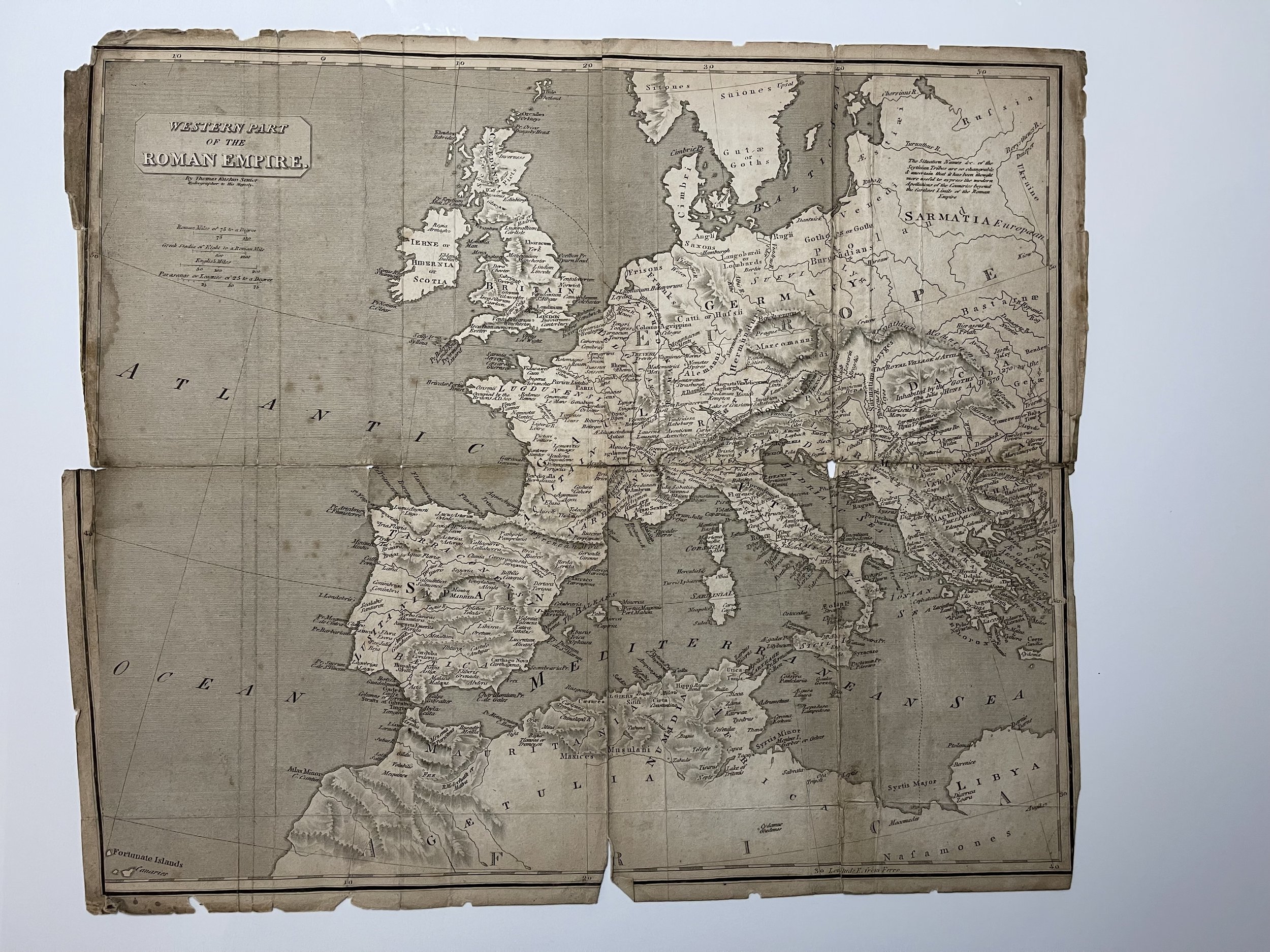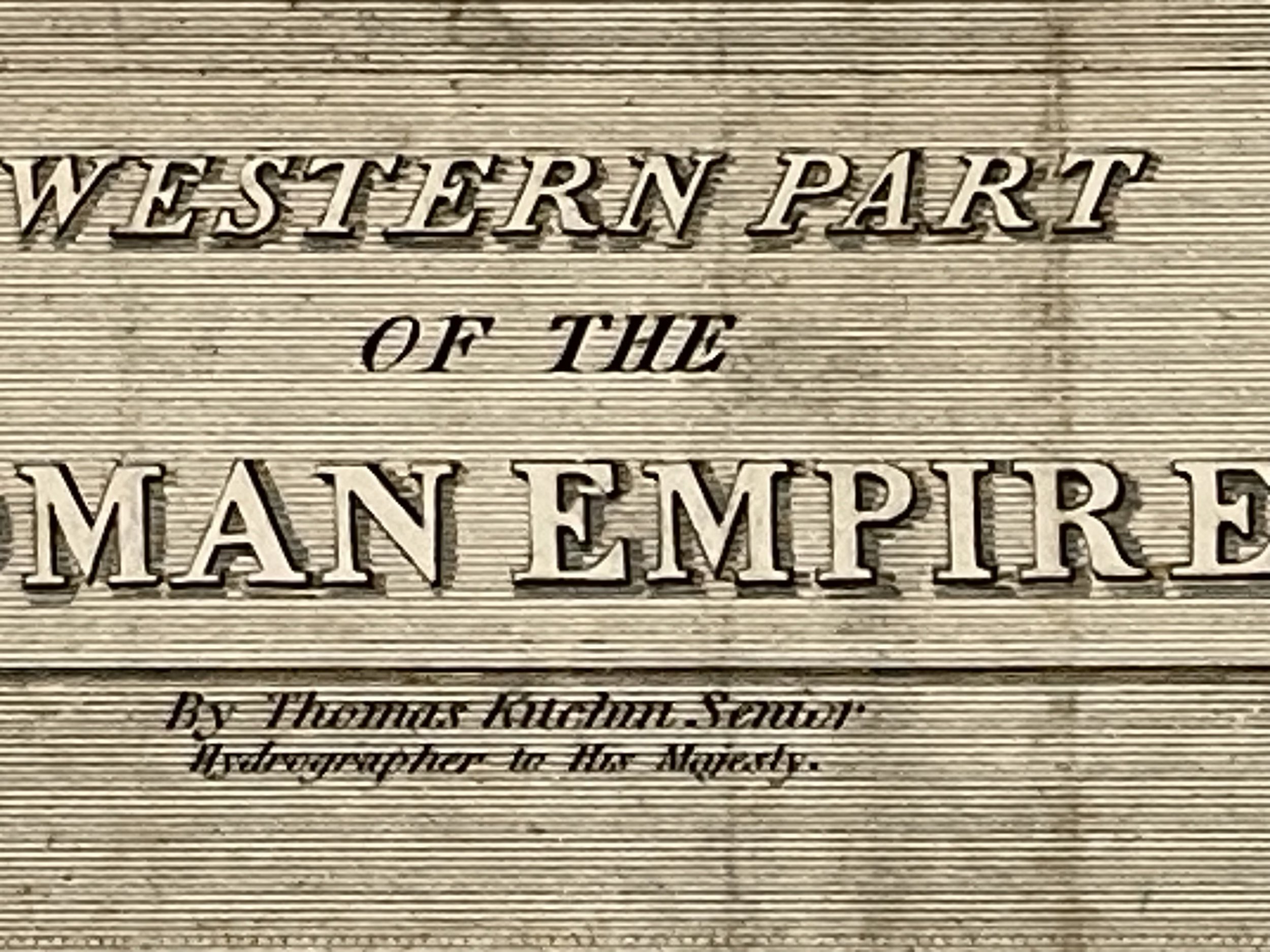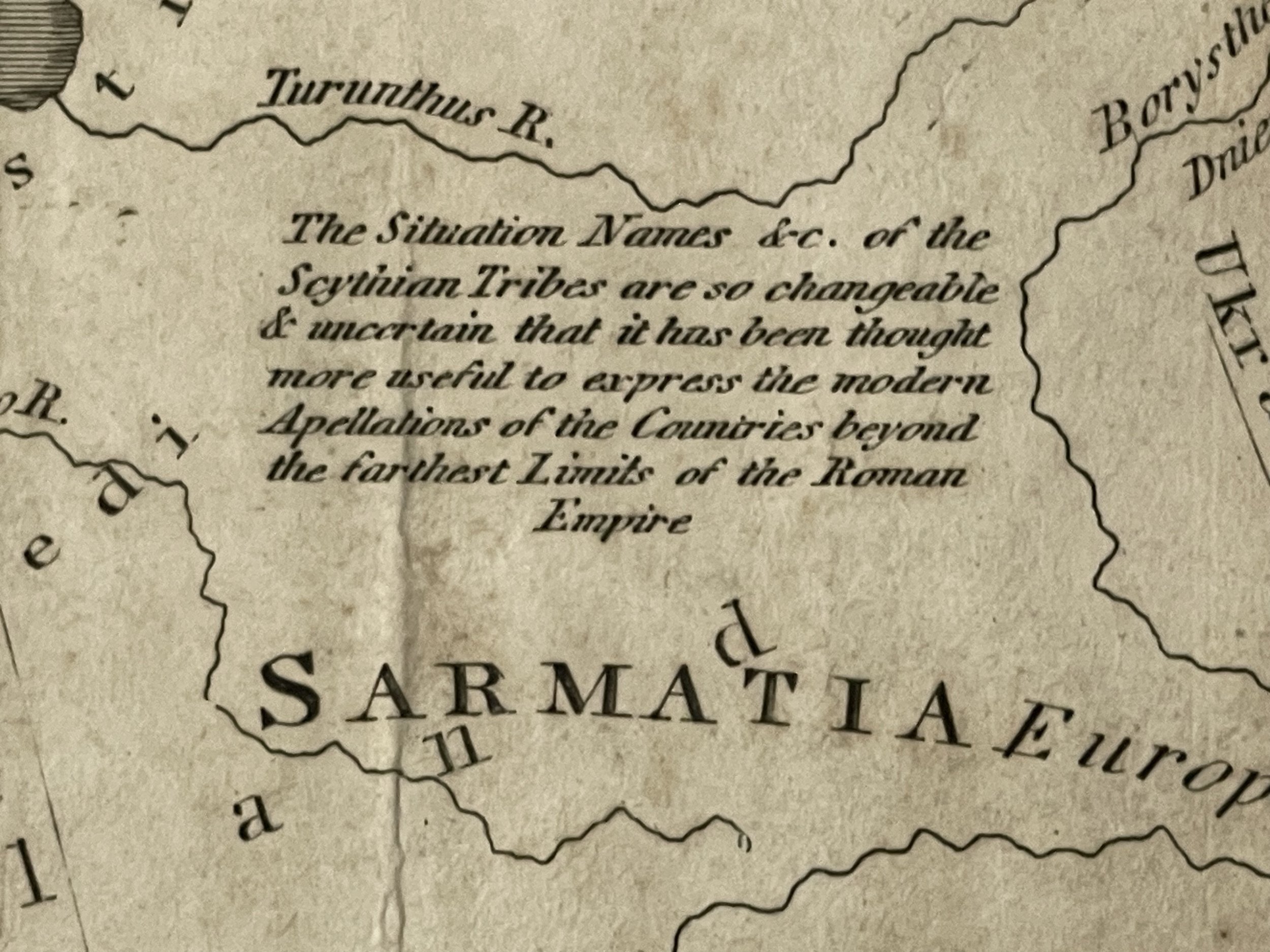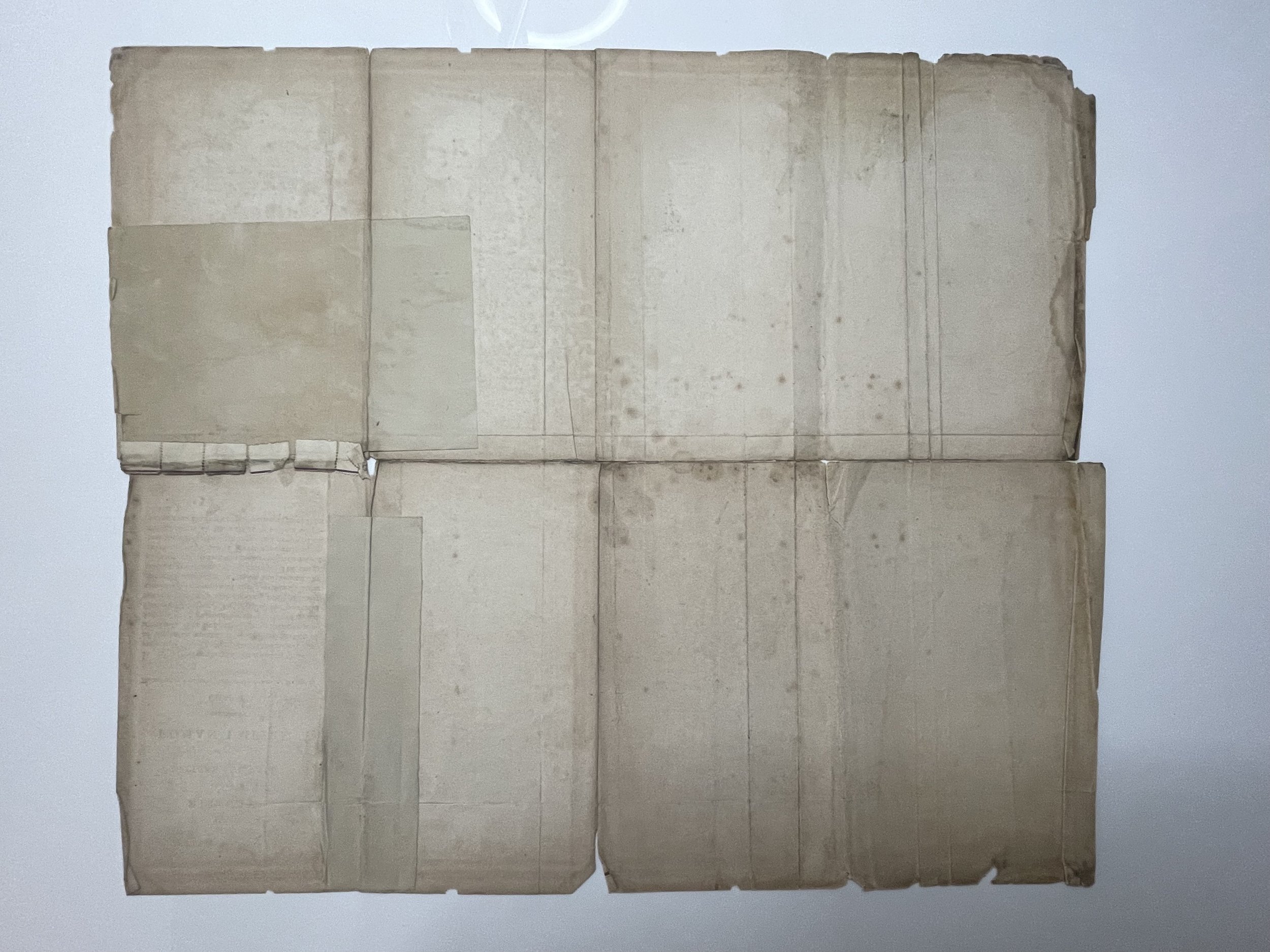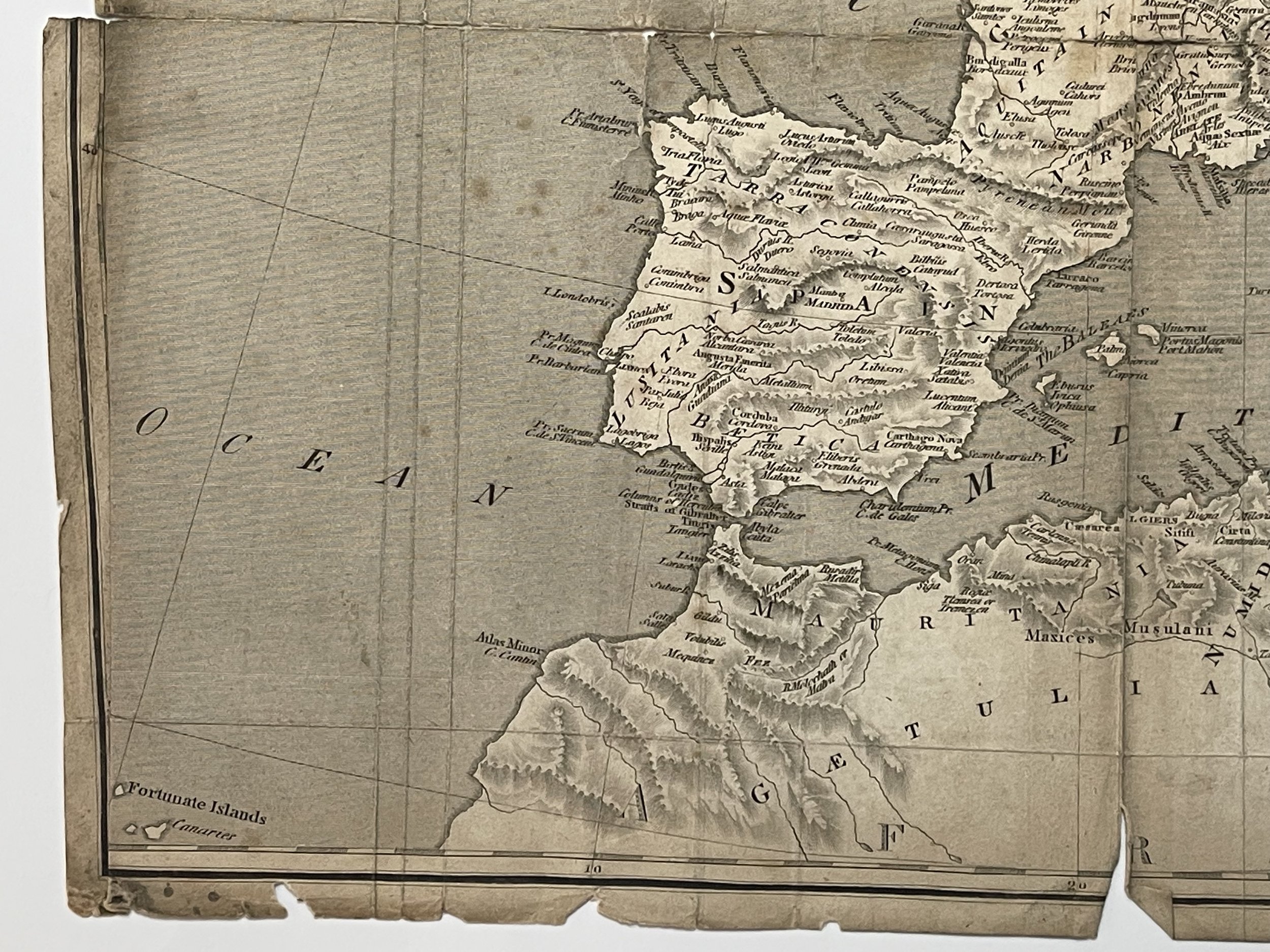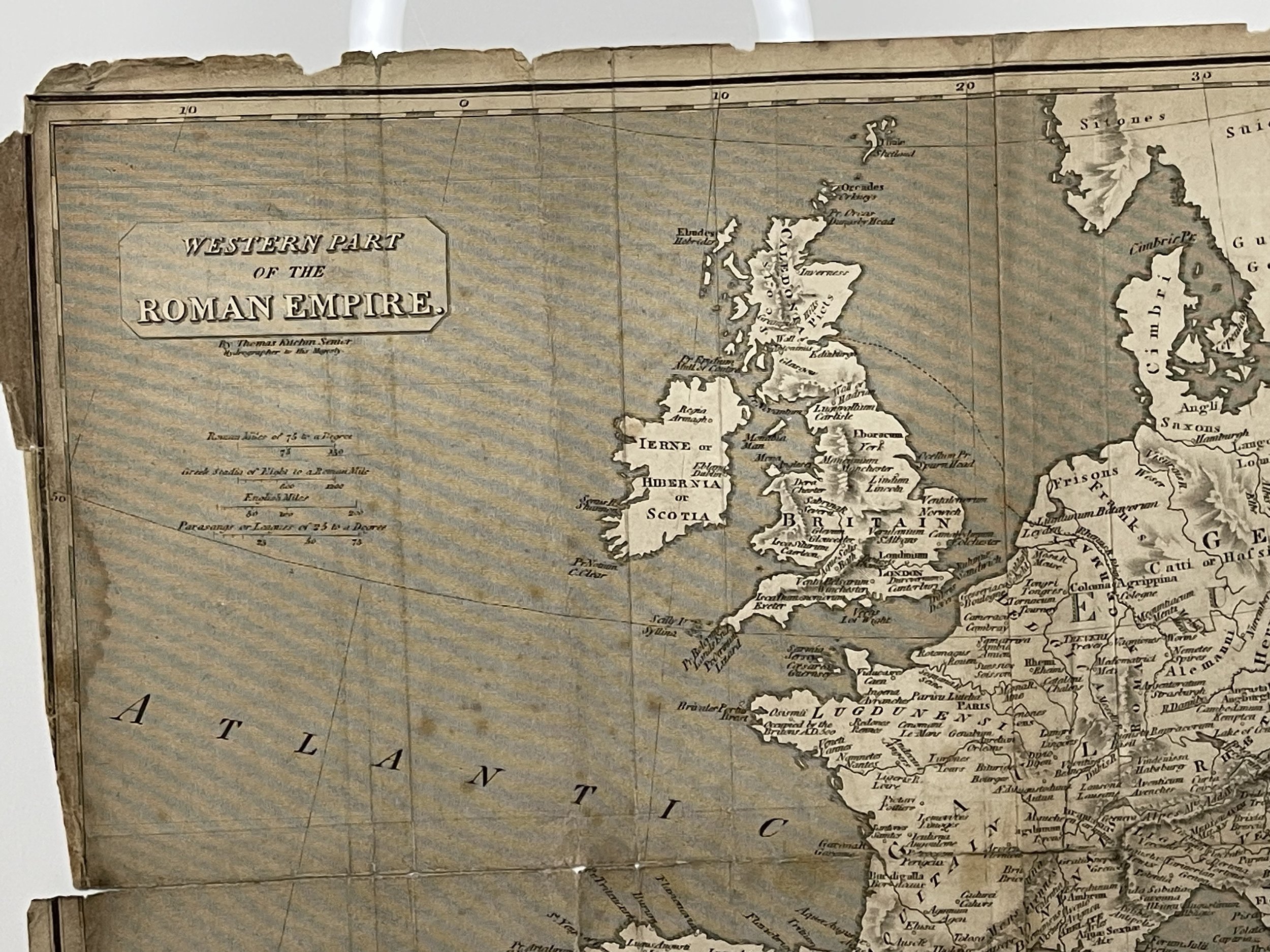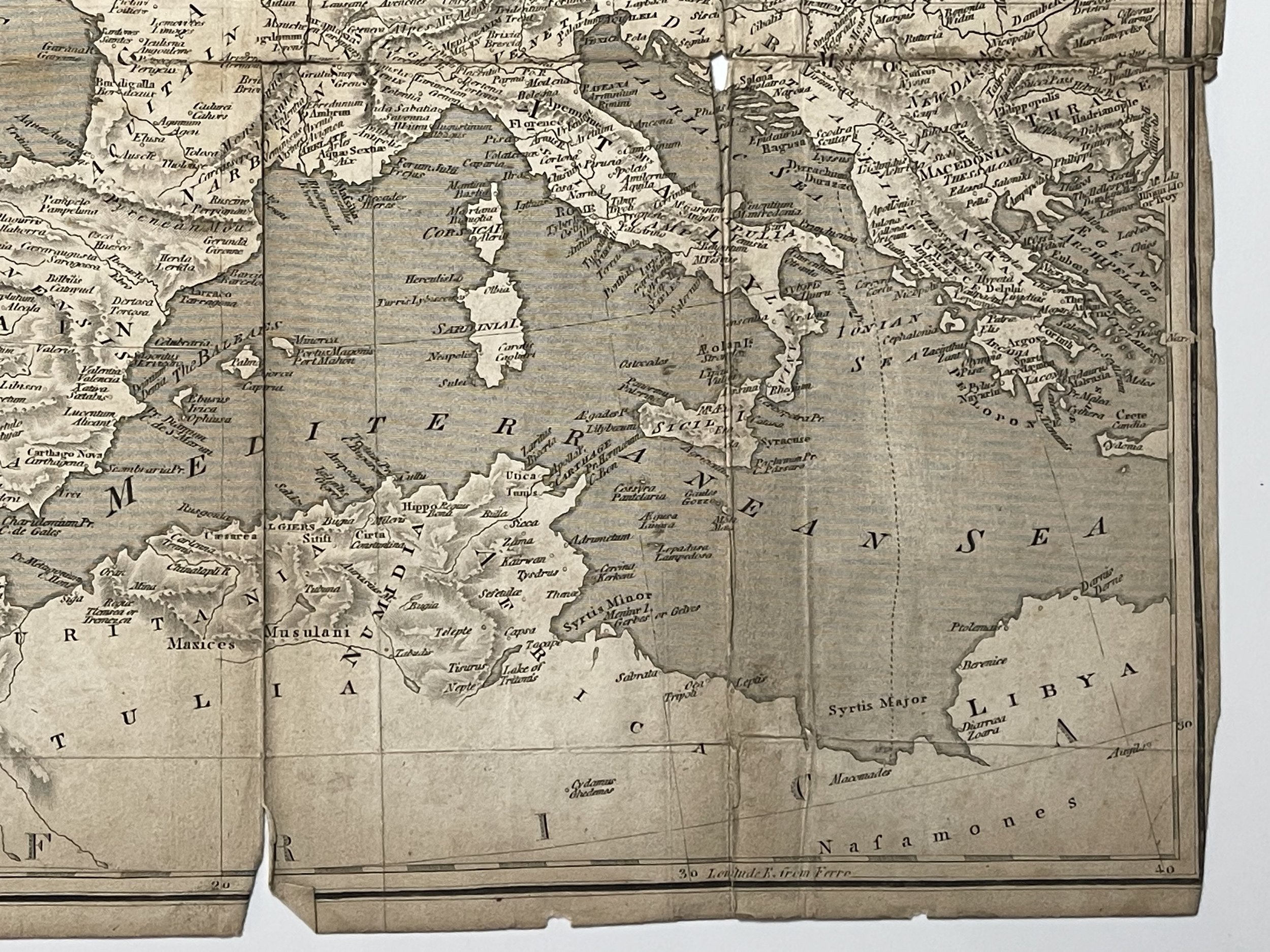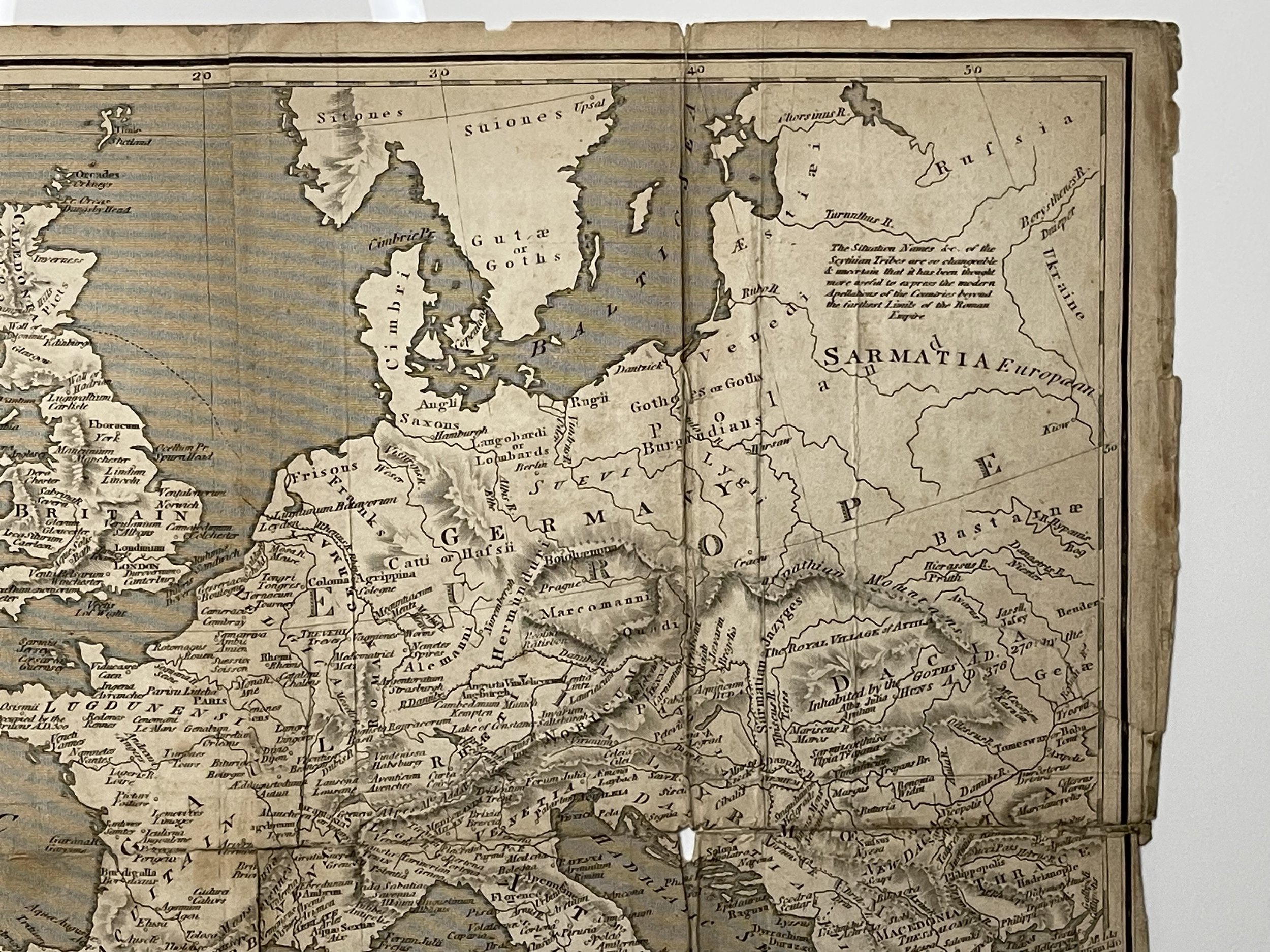The Western Territory of the Roman Empire - Thomas Kitchin Senior / Edward Gibbon - C 1782 - 1845
Map of the Western Territory of the Roman Empire - Thomas Kitchin Senior 1782-1845
From a folio ‘History Of The Decline And Fall Of The Roman Empire’ - Edward Gibbon, Esq. With notes by the Rev. H. H. Milman - 1782 (Written), 1845 (Revised).
The first original, First American Edition of 1836 was used as a reference for the many questions which came up during the re-proofing and renovation of the 1996 and 1997 Project Gutenberg editions. Images of spines, front-leaf, frontispiece, and the titlepage of the 1836 set are inserted below along with the two large fold out maps.
The map itself is in poor condition with spilts, stains and foxing present. An aged survivor. Grading and pricing commensurate.
Thomas Kitchin (also Kitchen; 1718–1784) was an English engraver and cartographer, who became hydrographer to the king. He was also a writer, who wrote about the history of the West Indies.
He was born in Southwark and was apprenticed to Emanuel Bowen in 1732. Originally based in Clerkenwell, by late 1755 Kitchin was established on Holborn Hill. From 1773 Kitchin was royal hydrographer to the king. He married Sarah Bowen, daughter of Emanuel, in 1739, and then Jane, daughter of Joseph Burroughs, in 1762. He died in St Albans on 23 June 1784. Kitchin lived and worked in London until his retirement.
He produced John Elphinstone's map of Scotland (1746), Geographia Scotiae (1749), and The Small English Atlas (1749) with Thomas Jeffery’s. The Large English Atlas (with Bowen 1749–60) was a serious attempt to cover England at large scale. In 1755 Kitchin engraved the Mitchell Map of North America.[citation needed] He worked for London Magazine. He produced 170 maps for London Magazine (1747–83).[citation needed] Kitchin was the head hydrographer for the King of England. Kitchin frequently stole the works of other cartographers, which is one reason why he "created" so much work as a cartographer.
His book, The Present State of the West-Indies: Containing an Accurate Description of What Parts Are Possessed by the Several Powers in Europe was published in 1778 bt R. Baldwin in London.
In 1783, he wrote, The Traveller's Guide Through England and Wales, which listed most towns and cities with mileages back to London.
Kitchin died in June 1784 and was buried in St Alban's Cathedral. His memorial stone has not survived.
Edward Gibbon FRS (8 May 1737 – 16 January 1794) was an English essayist, historian, and politician. His most important work, The History of the Decline and Fall of the Roman Empire, published in six volumes between 1776 and 1789, is known for the quality and irony of its prose, its use of primary sources, and its polemical criticism of organized religion.
Following a stay at Bath in 1752 to improve his health at the age of 15, Gibbon was sent by his father to Magdalen College, Oxford, where he was enrolled as a gentleman-commoner. He was ill-suited, however, to the college atmosphere, and later rued his 14 months there as the "most idle and unprofitable" of his life. Because he says so in his autobiography, it used to be thought that a penchant from his aunt for "theological controversy" bloomed under the influence of the deist or rationalist theologian Conyers Middleton (1683–1750), the author of Free Inquiry into the Miraculous Powers (1749). In that tract, Middleton denied the validity of such powers; Gibbon promptly objected, or so the argument used to run. The product of that disagreement, with some assistance from the work of Catholic Bishop Jacques-Bénigne Bossuet (1627–1704), and that of the Elizabethan Jesuit Robert Parsons (1546–1610), yielded the most memorable event of his time at Oxford: his conversion to Roman Catholicism on 8 June 1753. He was further "corrupted" by the 'free thinking' deism of the playwright and poet David Mallet; and finally, Gibbon's father, already "in despair," had had enough. David Womersley has shown, however, that Gibbon's claim to having been converted by a reading of Middleton is very unlikely and was introduced only into the final draft of the "Memoirs" in 1792–93.
Within weeks of his conversion, he was removed from Oxford and sent to live under the care and tutelage of Daniel Pavillard, Reformed pastor of Lausanne, Switzerland. There, he made one of his life's two great friendships, that of Jacques Georges Deyverdun (the French-language translator of Goethe's The Sorrows of Young Werther), and that of John Baker Holroyd (later Lord Sheffield). Just a year and a half later, after his father threatened to disinherit him, on Christmas Day, 1754, he reconverted to Protestantism. "The various articles of the Romish creed," he wrote, "disappeared like a dream".
Map of the Western Territory of the Roman Empire - Thomas Kitchin Senior 1782-1845
From a folio ‘History Of The Decline And Fall Of The Roman Empire’ - Edward Gibbon, Esq. With notes by the Rev. H. H. Milman - 1782 (Written), 1845 (Revised).
The first original, First American Edition of 1836 was used as a reference for the many questions which came up during the re-proofing and renovation of the 1996 and 1997 Project Gutenberg editions. Images of spines, front-leaf, frontispiece, and the titlepage of the 1836 set are inserted below along with the two large fold out maps.
The map itself is in poor condition with spilts, stains and foxing present. An aged survivor. Grading and pricing commensurate.
Thomas Kitchin (also Kitchen; 1718–1784) was an English engraver and cartographer, who became hydrographer to the king. He was also a writer, who wrote about the history of the West Indies.
He was born in Southwark and was apprenticed to Emanuel Bowen in 1732. Originally based in Clerkenwell, by late 1755 Kitchin was established on Holborn Hill. From 1773 Kitchin was royal hydrographer to the king. He married Sarah Bowen, daughter of Emanuel, in 1739, and then Jane, daughter of Joseph Burroughs, in 1762. He died in St Albans on 23 June 1784. Kitchin lived and worked in London until his retirement.
He produced John Elphinstone's map of Scotland (1746), Geographia Scotiae (1749), and The Small English Atlas (1749) with Thomas Jeffery’s. The Large English Atlas (with Bowen 1749–60) was a serious attempt to cover England at large scale. In 1755 Kitchin engraved the Mitchell Map of North America.[citation needed] He worked for London Magazine. He produced 170 maps for London Magazine (1747–83).[citation needed] Kitchin was the head hydrographer for the King of England. Kitchin frequently stole the works of other cartographers, which is one reason why he "created" so much work as a cartographer.
His book, The Present State of the West-Indies: Containing an Accurate Description of What Parts Are Possessed by the Several Powers in Europe was published in 1778 bt R. Baldwin in London.
In 1783, he wrote, The Traveller's Guide Through England and Wales, which listed most towns and cities with mileages back to London.
Kitchin died in June 1784 and was buried in St Alban's Cathedral. His memorial stone has not survived.
Edward Gibbon FRS (8 May 1737 – 16 January 1794) was an English essayist, historian, and politician. His most important work, The History of the Decline and Fall of the Roman Empire, published in six volumes between 1776 and 1789, is known for the quality and irony of its prose, its use of primary sources, and its polemical criticism of organized religion.
Following a stay at Bath in 1752 to improve his health at the age of 15, Gibbon was sent by his father to Magdalen College, Oxford, where he was enrolled as a gentleman-commoner. He was ill-suited, however, to the college atmosphere, and later rued his 14 months there as the "most idle and unprofitable" of his life. Because he says so in his autobiography, it used to be thought that a penchant from his aunt for "theological controversy" bloomed under the influence of the deist or rationalist theologian Conyers Middleton (1683–1750), the author of Free Inquiry into the Miraculous Powers (1749). In that tract, Middleton denied the validity of such powers; Gibbon promptly objected, or so the argument used to run. The product of that disagreement, with some assistance from the work of Catholic Bishop Jacques-Bénigne Bossuet (1627–1704), and that of the Elizabethan Jesuit Robert Parsons (1546–1610), yielded the most memorable event of his time at Oxford: his conversion to Roman Catholicism on 8 June 1753. He was further "corrupted" by the 'free thinking' deism of the playwright and poet David Mallet; and finally, Gibbon's father, already "in despair," had had enough. David Womersley has shown, however, that Gibbon's claim to having been converted by a reading of Middleton is very unlikely and was introduced only into the final draft of the "Memoirs" in 1792–93.
Within weeks of his conversion, he was removed from Oxford and sent to live under the care and tutelage of Daniel Pavillard, Reformed pastor of Lausanne, Switzerland. There, he made one of his life's two great friendships, that of Jacques Georges Deyverdun (the French-language translator of Goethe's The Sorrows of Young Werther), and that of John Baker Holroyd (later Lord Sheffield). Just a year and a half later, after his father threatened to disinherit him, on Christmas Day, 1754, he reconverted to Protestantism. "The various articles of the Romish creed," he wrote, "disappeared like a dream".
Map of the Western Territory of the Roman Empire - Thomas Kitchin Senior 1782-1845
From a folio ‘History Of The Decline And Fall Of The Roman Empire’ - Edward Gibbon, Esq. With notes by the Rev. H. H. Milman - 1782 (Written), 1845 (Revised).
The first original, First American Edition of 1836 was used as a reference for the many questions which came up during the re-proofing and renovation of the 1996 and 1997 Project Gutenberg editions. Images of spines, front-leaf, frontispiece, and the titlepage of the 1836 set are inserted below along with the two large fold out maps.
The map itself is in poor condition with spilts, stains and foxing present. An aged survivor. Grading and pricing commensurate.
Thomas Kitchin (also Kitchen; 1718–1784) was an English engraver and cartographer, who became hydrographer to the king. He was also a writer, who wrote about the history of the West Indies.
He was born in Southwark and was apprenticed to Emanuel Bowen in 1732. Originally based in Clerkenwell, by late 1755 Kitchin was established on Holborn Hill. From 1773 Kitchin was royal hydrographer to the king. He married Sarah Bowen, daughter of Emanuel, in 1739, and then Jane, daughter of Joseph Burroughs, in 1762. He died in St Albans on 23 June 1784. Kitchin lived and worked in London until his retirement.
He produced John Elphinstone's map of Scotland (1746), Geographia Scotiae (1749), and The Small English Atlas (1749) with Thomas Jeffery’s. The Large English Atlas (with Bowen 1749–60) was a serious attempt to cover England at large scale. In 1755 Kitchin engraved the Mitchell Map of North America.[citation needed] He worked for London Magazine. He produced 170 maps for London Magazine (1747–83).[citation needed] Kitchin was the head hydrographer for the King of England. Kitchin frequently stole the works of other cartographers, which is one reason why he "created" so much work as a cartographer.
His book, The Present State of the West-Indies: Containing an Accurate Description of What Parts Are Possessed by the Several Powers in Europe was published in 1778 bt R. Baldwin in London.
In 1783, he wrote, The Traveller's Guide Through England and Wales, which listed most towns and cities with mileages back to London.
Kitchin died in June 1784 and was buried in St Alban's Cathedral. His memorial stone has not survived.
Edward Gibbon FRS (8 May 1737 – 16 January 1794) was an English essayist, historian, and politician. His most important work, The History of the Decline and Fall of the Roman Empire, published in six volumes between 1776 and 1789, is known for the quality and irony of its prose, its use of primary sources, and its polemical criticism of organized religion.
Following a stay at Bath in 1752 to improve his health at the age of 15, Gibbon was sent by his father to Magdalen College, Oxford, where he was enrolled as a gentleman-commoner. He was ill-suited, however, to the college atmosphere, and later rued his 14 months there as the "most idle and unprofitable" of his life. Because he says so in his autobiography, it used to be thought that a penchant from his aunt for "theological controversy" bloomed under the influence of the deist or rationalist theologian Conyers Middleton (1683–1750), the author of Free Inquiry into the Miraculous Powers (1749). In that tract, Middleton denied the validity of such powers; Gibbon promptly objected, or so the argument used to run. The product of that disagreement, with some assistance from the work of Catholic Bishop Jacques-Bénigne Bossuet (1627–1704), and that of the Elizabethan Jesuit Robert Parsons (1546–1610), yielded the most memorable event of his time at Oxford: his conversion to Roman Catholicism on 8 June 1753. He was further "corrupted" by the 'free thinking' deism of the playwright and poet David Mallet; and finally, Gibbon's father, already "in despair," had had enough. David Womersley has shown, however, that Gibbon's claim to having been converted by a reading of Middleton is very unlikely and was introduced only into the final draft of the "Memoirs" in 1792–93.
Within weeks of his conversion, he was removed from Oxford and sent to live under the care and tutelage of Daniel Pavillard, Reformed pastor of Lausanne, Switzerland. There, he made one of his life's two great friendships, that of Jacques Georges Deyverdun (the French-language translator of Goethe's The Sorrows of Young Werther), and that of John Baker Holroyd (later Lord Sheffield). Just a year and a half later, after his father threatened to disinherit him, on Christmas Day, 1754, he reconverted to Protestantism. "The various articles of the Romish creed," he wrote, "disappeared like a dream".
Code : A54
Cartographer : Cartographer / Engraver / Publisher: Thomas Kitchin Senior / Edward Gibbon folio
Date : Publication Place / Date - Circa 1845
Size : Sheet size: Image Size: 49 x 42 cm
Availability : Available
Type - Genuine - Antique
Grading C
Where Applicable - Folds as issued. Light box photo shows the folio leaf centre margin hinge ‘glue’, this is not visible otherwise.
Tracked postage, in casement. Please contact me for postal quotation outside of the UK.
